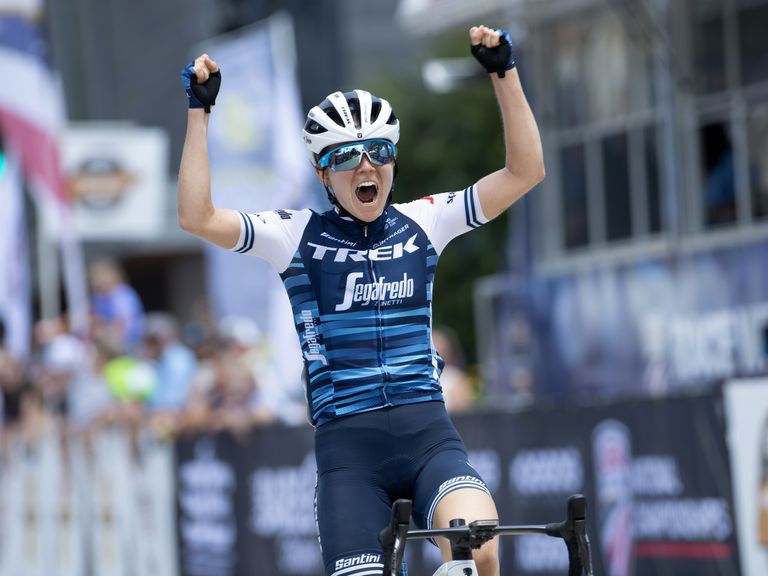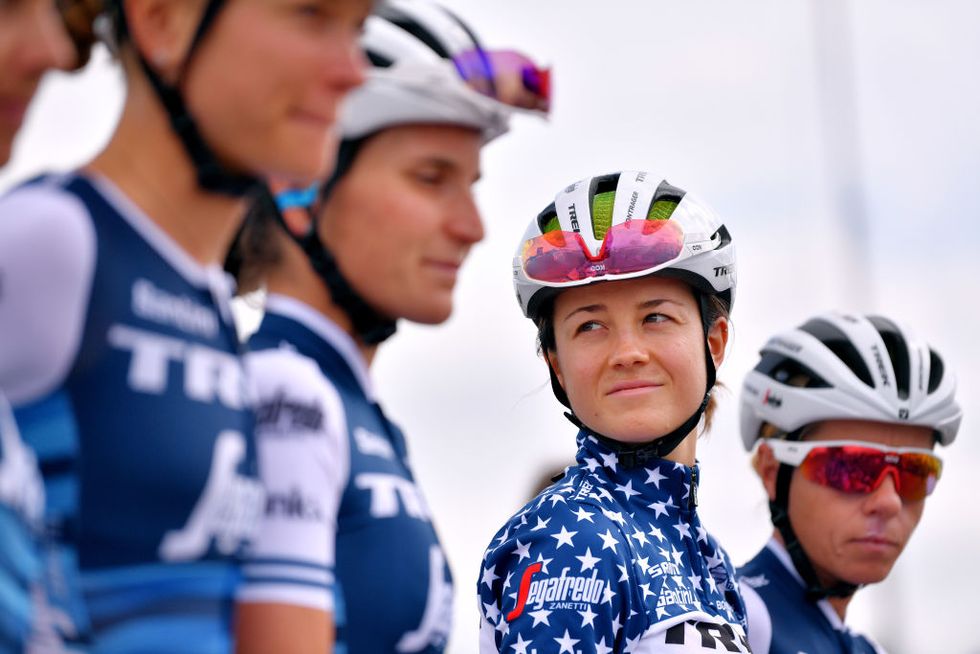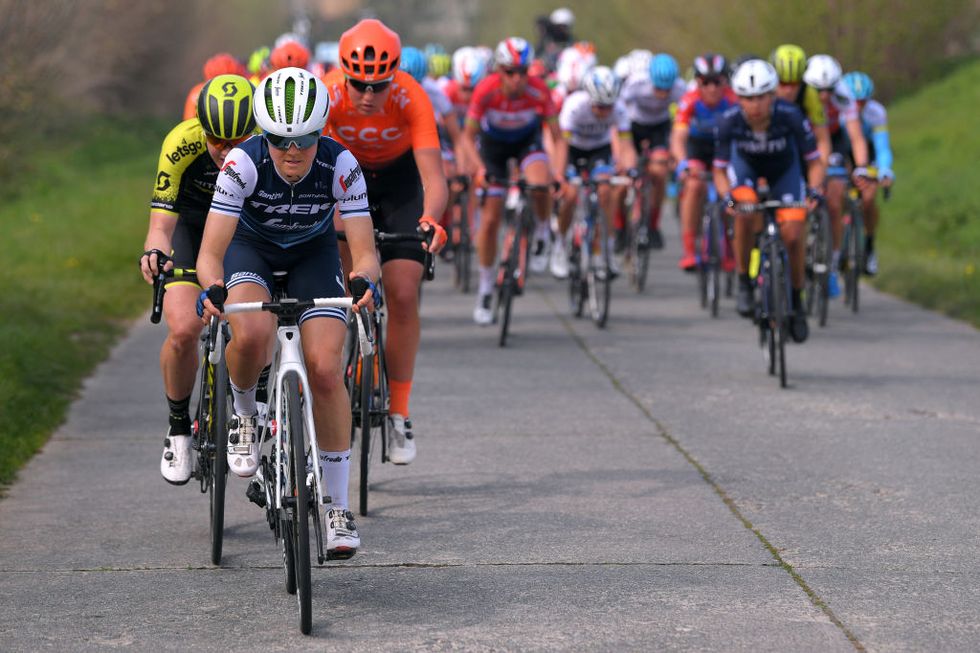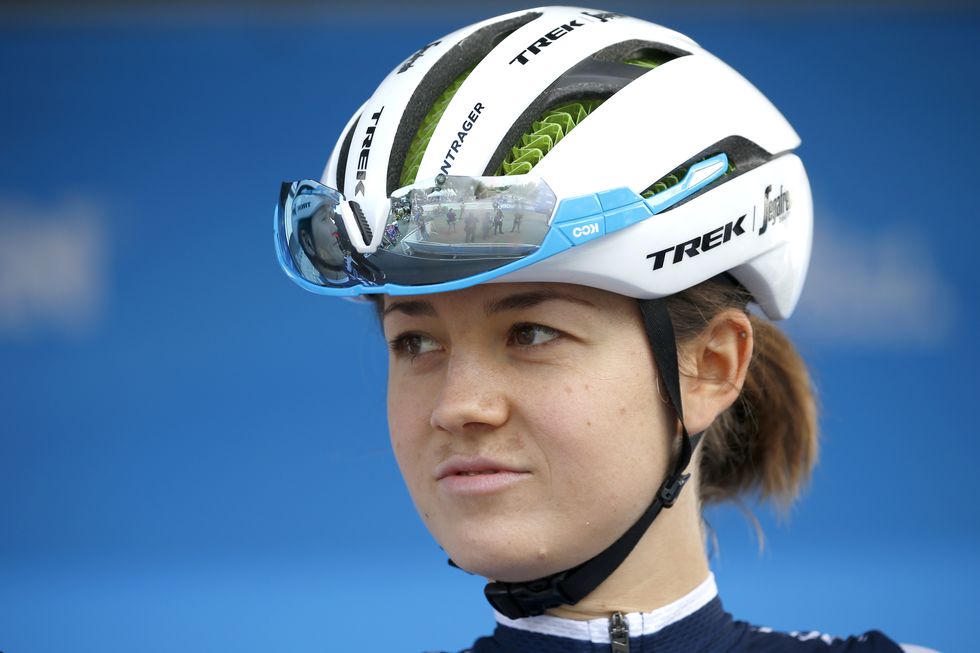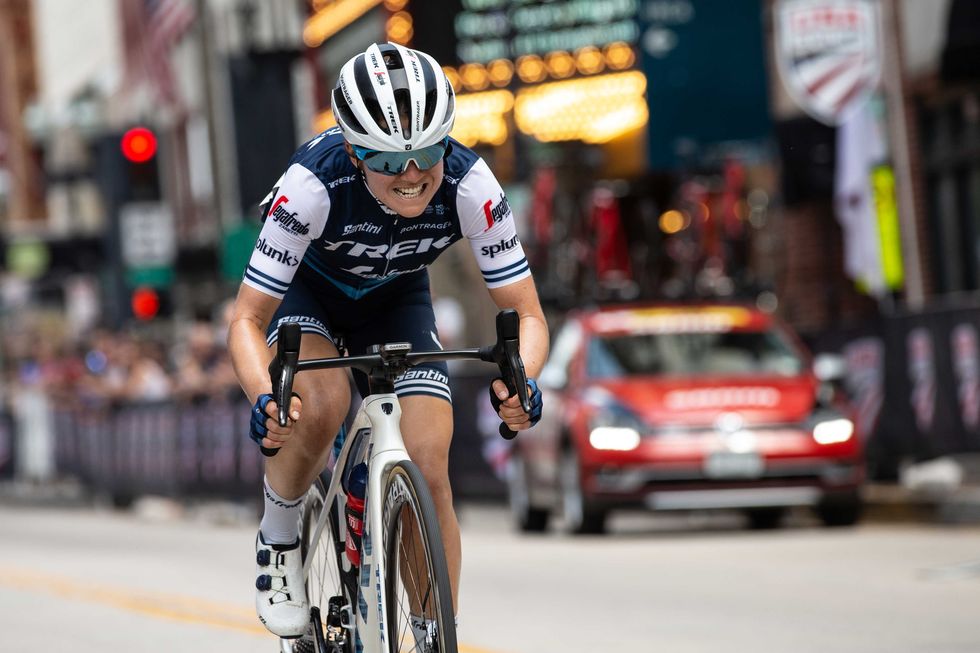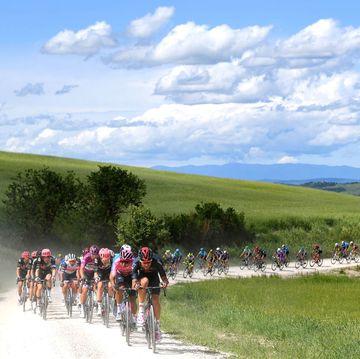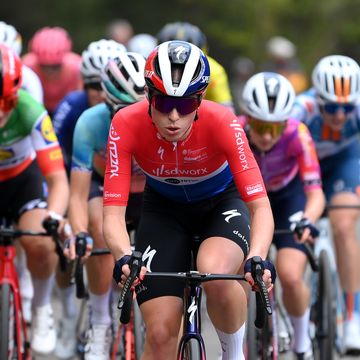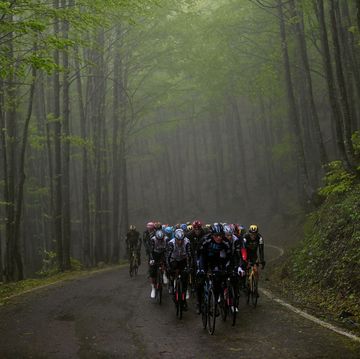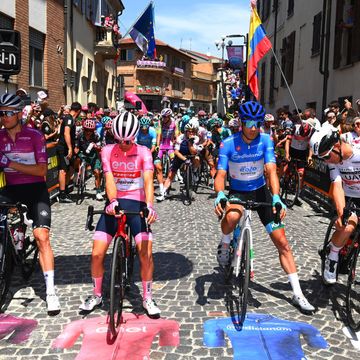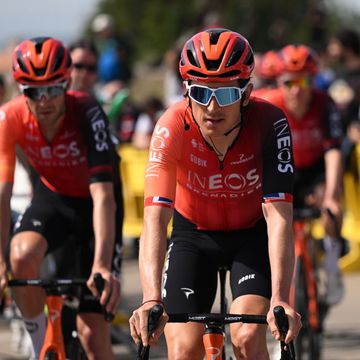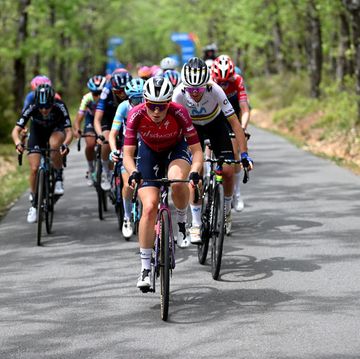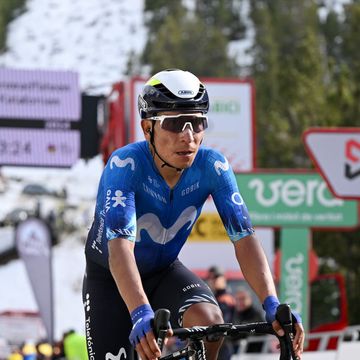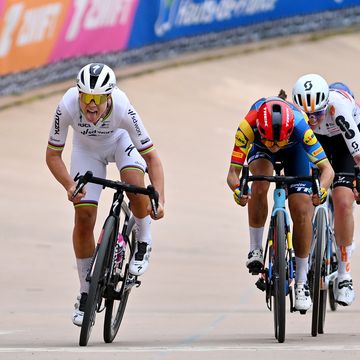When Trek-Segafredo’s Ruth Winder crossed the finish line at this year’s pro road national championships in Knoxville, she was absolutely gobsmacked. She’d finished first, two seconds ahead of defending champ and former teammate Coryn Rivera. Mouth agape, Winder shook her head in disbelief and then raised one hand, palm up, as if to say, how the hell did that just happen?
Earning a stars and stripes jersey wasn’t a new experience for Winder—she won one on the road (2009), one on the track as a junior (2010), and two on the track at the elite level (2010, 2013). But the fact that she did it this year was a surprise, because in the months leading up to the race, Winder had been quietly dealing with a common but often overlooked sports-related medical issue that was wearing away her physical and mental health.
Here, for the first time, she opens up about how she figured out what was wrong and how she managed to salvage her 2019 season.
New Team, New Expectations
To understand Winder’s shock at her 2019 win, you have to go back to 2018. After a breakout season racing as a domestic pro for UnitedHealthcare, she joined Team Sunweb and moved to the Netherlands.
Winder is known for her explosive power, which Sunweb recognized as being valuable on short, punchy climbs, possibly because of how well she raced at the Tour of California in 2017. But Winder had never thought of herself as a climber. “Everybody just kept telling me that I was a climber,” says Winder. “And I was like, ‘Woah, this is news to me.’”
Winder knew climbers need to be as light as possible and that having a high power-to-weight ratio is key. She says a Sunweb nutritionist suggested shaving a kilogram, or about two pounds, off her already slight 5’4” frame; she didn’t question this logic. Winder says the team’s nutritionist recommended eating 1,500 calories a day plus whatever she burned while on the bike—with the caveat that if Winder was hungry, she should eat more. (A Sunweb spokesperson says riders are given nutrition information and example menus that vary in calorie intake depending on training intensity; the spokesperson added that in Winder’s case, the focus was on good, basic nutrition, not on target numbers for weight).
But here’s the thing with Winder: She’s a perfectionist. So she was fastidious about counting calories. Her mindset at the time, she says, was “I can deal with being a little bit hungry.”
Winder says she lost a pound, maybe. But instead of her performance improving, it became inconsistent. Worse, she was hungry and irritable all the time, and her period, which had always arrived like clockwork, became erratic. It was July, and she’d only gotten it twice since changing her diet in February.
Winder consulted with Sunweb staff who agreed that her extreme focus on her weight and calorie-counting had become unhealthy. They advised her to listen to her body and supported her in returning to her regular style of eating—aiming only for a balanced plate of protein, carbs, and healthy fats at every meal. She still felt sluggish but that summer she won a stage of the Giro D’Italia and two at the Tour de Feminin. She even got her period once, in August. But it didn’t become regular again.
An Off Off-Season
At the end of the 2018 season, Winder signed with the newly formed Trek-Segafredo women’s team for 2019 and linked back up with Ben Day, who had coached her in 2017. The two discussed her missed periods. Day didn’t think they were a “complete alarm-bells scenario,” but he was concerned. Here’s why:
Menstrual dysfunction is often the first sign that an athlete is in a state of low energy availability, or taking in too few calories for the body to operate properly. That’s because when the body doesn’t have enough energy to support all its functions, it prioritizes the most important ones. As a result, processes like reproduction, which the menstrual cycle is a part of, are suppressed in favor of processes such as cell maintenance. Over time, those missed periods can lead to a drop in systemic estrogen levels, which can cause thinning bones.
When an athlete suffers from all three—low energy availability (with or without disordered eating), menstrual dysfunction, and low bone density—she’s said to have the Female Athlete Triad, a spectrum of disorders with long-term health effects. Body weight plays a role in screening, but isn’t part of the diagnostic criteria because when the body is in conservation mode, it unleashes a cascade of hormonal disruptions that can slow metabolism and increase fat storage, both of which can keep weight steady.
Technically Winder didn’t have the Triad because her bone density was normal. But Day worried that she was at risk for developing it or Relative Energy Deficiency in Sport, or RED-S, a broader (though contentious) term for the Triad. Either way, the risks were similar: Experts believe both the Triad and RED-S can lead to diminished athletic performance, osteoporosis, stress fractures, cardiovascular issues, and gastrointestinal problems, among others.
Day prescribed Winder nearly five weeks off the bike—a longer period of time than what he’d normally recommend during the off-season—and then slowly eased her back into training.
Calling for Backup
Winder started the 2019 season strong, winning the first stage of Setmana Ciclista Valenciana, and finishing eleventh overall at Strade Bianche in early March. But between races she often felt sluggish. “She wasn’t responding to heavy work like she should,” says Day. Instead of adapting and getting stronger, she remained fatigued. Equally worrying, she had only gotten her period once since August.
Day reached out to Stacy Sims, Ph.D., a competitive athlete turned exercise physiologist and nutrition scientist who has studied how sex affects training, nutrition, and health. Sims reviewed Winder’s diet and training as well as her blood test and DEXA scan results and confirmed Day’s suspicions: Winder was suffering from low energy availability and menstrual dysfunction.
To restart a regular menstrual cycle, most athletes need to eat a minimum of 2,000 calories a day and train no more than eight hours a week, says Sims. But Winder was in the middle of the race season, so the latter wasn’t wasn’t going to be possible. Instead, Sims recommended that Day reduce Winder’s training to 10 to 12 hours a week.
Instead of counting calories, Sims gave Winder examples of what to eat before, during, and after different types of workouts and on recovery days to ensure she’d be getting the right mix of carbs, protein, and healthy fats at the right times.
“Stacy’s very much of the mindset that if you train hard and eat the right things, then your body will find the weight it wants to be at,” says Winder. “So we focused on when, how, and what I was eating, rather than on how much I was eating and what my weight was.”
Still, Winder remained tired, sluggish, and not menstruating. Which is normal—it can take weeks, even months, for energy levels to come back up and up to a year for periods to become regular again. “As the spring went on and the chances to have good race results disappeared, I felt like I was letting myself and the team down,” she says.
Interval training became particularly fraught for Winder. If she couldn’t consistently hit the numbers Day set out for her, she felt demoralized. “One day I had quite the meltdown in the middle of a ride. I actually texted Ben and was like, I don’t know why I can’t do these intervals.”
Day told her to eat some sugar (she had marshmallows stashed in her jersey pocket), change the screen on her bike computer so that all she could see was the time, and then try the interval set again. After the workout, Winder reviewed her power data with Day and was shocked to see that her final three intervals were similar to the very first one she did, during which she’d achieved one of her best three-minute power readings ever.
Day realized that the pressure Winder was putting on herself was also derailing her performance. “What makes Ruth such a successful athlete is that she has so much drive and she kills herself out training every day,” says Day. “But it's also the thing that could potentially undo her.”
Back to Basics
Winder’s next two races—the Amgen Tour of California and the national championships—were both in the States, so she returned home to Boulder (she was splitting her time between the Colorado city and Girona, Spain) at the beginning of May. She continued to follow Sims’ nutrition advice, and traded interval training for mountain bike rides and criterium racing. She also started seeing a sports psychologist.
Heading into the national championships, Winder’s mental and physical health were slowly improving, but she was nervous. She worried her restricted training wasn’t going to be enough to do well at the race and shared her concerns with Day, who admitted he had been having similar thoughts.
Sims reviewed the results of Winder’s most recent blood test and then gave Day her blessing to amp up Winder’s training. “We did two weeks of a really focused build—we started to push the limits again—and then had a taper going into nationals,” says Day.
During that time in June, Winder received a really encouraging sign: Her period returned for the first time since February.
Earning the Stars and Stripes
In true storybook fashion, Winder didn’t just win nationals, she did it in dramatic fashion, launching a solo counterattack 21 miles from the finish. When the peloton fought back to get within seconds of her, she dug in and put more distance between herself and the pack. “After the climb on the last lap, I was just staring at the white line on the road, going as hard as I could, and kept thinking, ‘be in the moment.’”
Sims wasn’t surprised by Winder’s result. “Ruth had been working really hard on the mental aspect [of her experience]. In my head I was like, if it clicks on that day, she’s going to fly. And it did. It clicked.”
For Winder, maintaining a sense of balance, both mentally and physically, is a work in progress. “I’ve learned that it’s ok to let yourself feel something. That it doesn’t mean you’re weak. It doesn’t mean you’re not tough,” she says. For example, instead of worrying that she’s not perfect if she struggles during a workout, she has a new strategy: “I feel [my emotions]. Really, really feel them for 30 seconds and then I try and let it go.”
Since Nationals, Winder has continued to get physically and mentally stronger. She helped her team win the UCI Women’s WorldTour time trial in Sweden, won her first WorldTour top 10 the next day in the road race, and then won the prologue of the Lotto Belgium Tour in early September. And her period? It returned again in July and August, marking three months back-to-back—her longest stretch of regular menstruation since this whole ordeal began.
“I've been feeling super strong. I'm less irritable, I have fewer meltdowns, I have less stress, and I think those things add up to make me faster. Things are happening. Happy things are happening in my body.”
